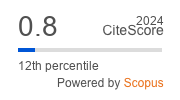Mathematical modeling of the metrical parameters of hexagonal close-packed metalls
https://doi.org/10.17073/1609-3577-2022-4-283-287
EDN: JVKVOD
Abstract
The electronic, magnetic, mechanical and other properties of crystalline substances are due to the feature of their structure — the periodicity and symmetry of the lattice, therefore, the determination of the metrical parameters is an important stage in the study of the characteristics of such materials. The paper considers a number of metals having a crystal lattice of the hcp structural type (hexagonal close packing) – beryllium, cerium, cobalt, dysprosium, erbium, gadolinium, hafnium, holmium, lanthanum, lutetium, magnesium, neodymium, osmium, praseodymium, rhenium, ruthenium, scandium, terbium, titanium, thallium, thulium, yttrium, zirconium. The paper shows the application of the annealing simulation algorithm to find the metric parameters of the materials under consideration using the dense packing model, which is widely used in crystallographic calculations. The own software implementation of the annealing simulation algorithm presented in the paper makes it possible to determine the coordinates of the atoms included in the unit cell of the crystal lattice, to calculate the lattice constants and the packing density of atoms in the cell of the crystal of the hcp structural type, using the given chemical formula and space symmetry group. These structural characteristics can be used as input parameters in modeling the electronic, magnetic, and other properties of the considered materials. The paper compares the values of the crystal lattice constants obtained as a result of numerical simulation with published data.
About the Author
P. A. SechenykhRussian Federation
44-2 Vavilova Str., Moscow 119333;
4 Volokolamskoe Highway, Moscow 125993
Polina A. Sechenykh — Junior Researcher (1); Senior Lecturer (2)
References
1. Abgaryan K.K. Multiscale modeling in problems of structural materials science. Moscow: MAKS Press; 2017. 284 p. (In Russ.)
2. Shaskol’skaya M.P. Crystallography. Moscow: Vysshaya shkola; 1976. 391 p. (In Russ.)
3. Zagal’skaya Yu.G., Litvinskaya G.P., Egorov-Tismenko Yu.K. Geometric crystallography. 2nd ed. Moscow: Moscow University press; 1986. 165 p. (In Russ.)
4. Belov N.V. Structure of ionic crystals and metallic phases. Moscow: Izd-va Akad. nauk SSSR; 1947. 237 p. (In Russ.)
5. Sechenykh P.A., Abgaryan K.K. Mathematical modeling of the crystal structure of metal oxides. In: Proceed. of the inter. conf. “Mathematical modeling in materials science of electronic components” (ММMSEC-2019). October 21–23, 2019. Мoscow: MAKS Press; 2019. P. 74—76. (In Russ.). https://doi.org/10.29003/m682.MMMSEC-2019
6. Sechenykh P.A. Mathematical modeling of the crystal structure of perovskite-like materials. In: Proceed. of the III international conference “Mathematical modeling in materials science of electronic components” (ММMSEC-2021). October 25–27, 2021, Moscow. Moscow: MAKS Press; 2021. P. 86—88. (In Russ.). https://doi.org/10.29003/m2479.MMMSEC-2021/86-88
7. Hahn T., ed. Volume A. Space-group symmetry-2005. In: International tables for crystallography. 5th ed. Springer; 2005. 911 p. https://www.lpl.arizona.edu/PMRG/sites/lpl.arizona.edu.PMRG/files/ITC-Vol.A%20%282005%29%28ISBN%200792365909%29.pdf
8. Metropolis N., Ulam S. The Monte Carlo method. Journal of the American Statistical Association. 1949; 44(247): 335—341. https://doi.org/10.1080/01621459.1949.10483310
9. Documentation on C#. Getting started, guides, reference materials. (In Russ.). https://learn.microsoft.com/ru-ru/dotnet/csharp/ (accessed on 02.11.2019).
10. Technical documentation for SQL Server. SQL Server. Microsoft Learn. (In Russ.). https://learn.microsoft.com/ru-ru/sql/sql-server/?view=sql-server-ver15 (accessed on 01.11.2021).
11. Documentation for Entity Framework 6.1.3. (In Russ.). https://learn.microsoft.com/ru-ru/ef/ef6/what-is-new/past-releases#ef-613 (accessed on 01.11.2021).
12. Sechenykh P.A. Mathematical modeling of perspective structures of metal oxides. Izvestiya Vysshikh Uchebnykh Zavedenii. Materialy Elektronnoi Tekhniki = Materials of Electronics Engineering. 2019; 22(4): 268—271. (In Russ.). https://doi.org/10.17073/1609-3577-2019-4-268-271
13. The periodic table of the elements by WebElements. https://www.webelements.com (accessed on 20.09.2022).
14. Ashcroft N.W., Mermin N.D. Solid state physics. NY, USA: Saunders College Publishing; 1976. 848 p.
15. Hohenberg P., Kohn W. Inhomogeneous electron gas. Physical Review B. 1964; 136(3B): 864—871. https://doi.org/10.1103/PhysRev.136.B864
16. Kohn W., Sham L.J. Self-consistent equations including exchange and correlation effects. Physical Review A. 1965; 140(4A): 1133—1138. https://doi.org/10.1103/PhysRev.140.A1133
Review
For citations:
Sechenykh P.A. Mathematical modeling of the metrical parameters of hexagonal close-packed metalls. Izvestiya Vysshikh Uchebnykh Zavedenii. Materialy Elektronnoi Tekhniki = Materials of Electronics Engineering. 2022;25(4):283-287. (In Russ.) https://doi.org/10.17073/1609-3577-2022-4-283-287. EDN: JVKVOD





































